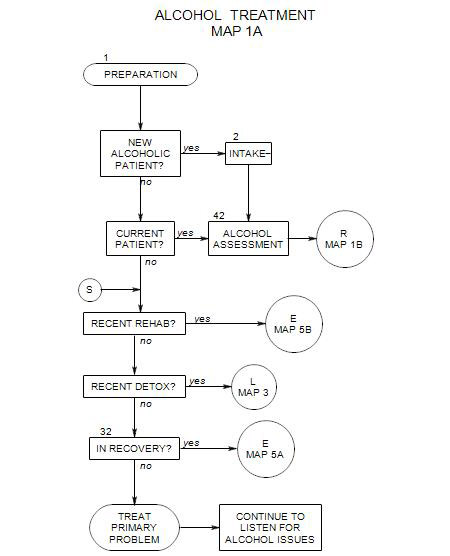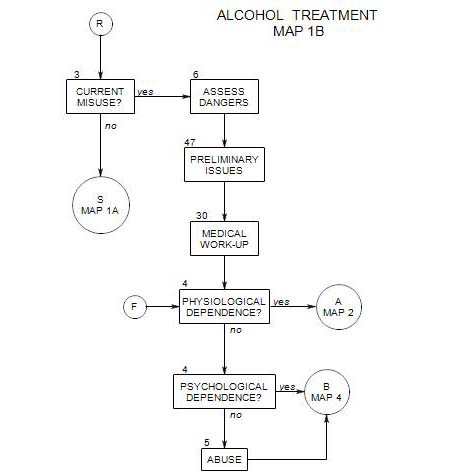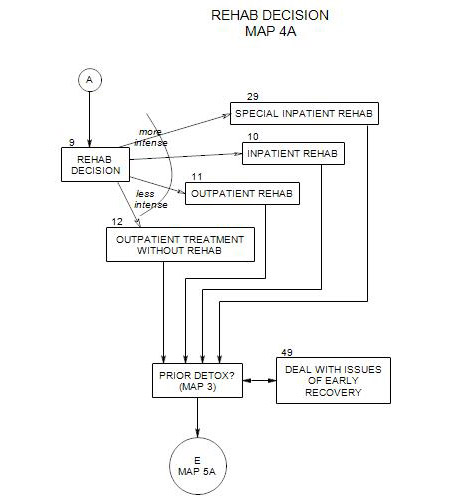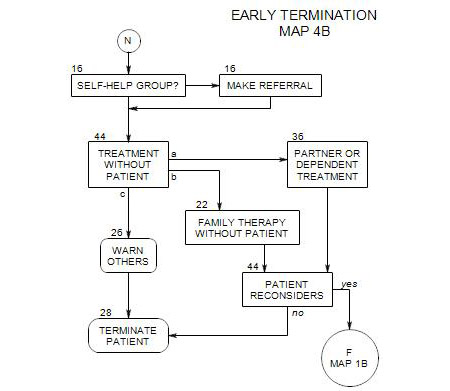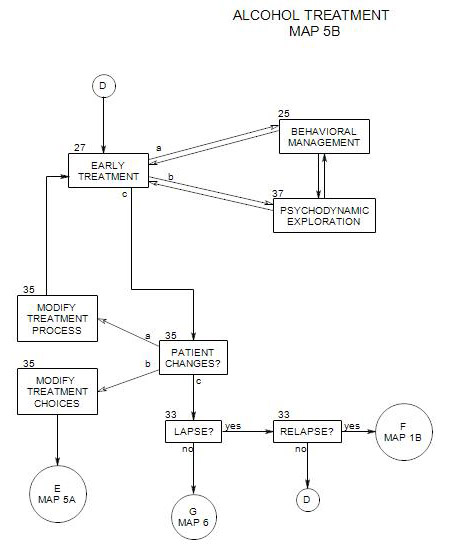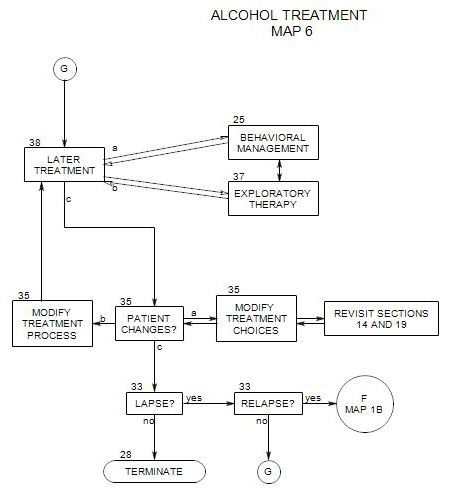6. DANGERS OF ALCOHOL MISUSE
- This section is intended to be used in conjunction with Section 2 and Section 42, making use of information gathered in intake sessions.
One of the first problems is to determine what kinds of risks the person is facing, and how serious they are. At intake, there are a variety of potential sources of information, including the patient, the patient’s family, reports from other professionals, and your own reaction to the patient in session.
Often the patient will be unaware of, or unwilling to admit to dangers; and the information will come from the patient’s family or network, the referral source, or discrepancies in the patient’s reports.
As treatment progresses, a fuller picture of the patient develops, from the treatment, contact with family and friends, and feedback from adjunctive care resources. Based on that, the dangers can be continually re-assessed both with regard to their quality and their seriousness.
6a. Kinds of Dangers
There are several kinds of dangers associated with alcohol dependence or abuse, each kind having varying degrees of urgency or seriousness:
Impaired judgment may lead the person to take physical or interpersonal or financial risks. It also may increase the natural risk in using equipment, such as power tools, kitchen knives, or automobiles. The most obvious risk to others can come from driving while intoxicated or alcohol-impaired. This risks the safety and lives of the patient’s family, friends, and others on the same roads with the patient.
Personality changes A person can become more belligerent, leading to fights with other adults , or physical or psychological abuse of a partner or children in the family. A person may also become more compliant, leading to an acceptance of abuse or a willingness to go along with unhealthy advice or to follow negative examples.
Physical consequences Acute alcohol reactions can include blackouts, loss of consciousness resulting in accidents, violent or suicidal behavior. Alcohol has a long term impact on a wide range of physiological systems.
Behavioral consequences may include
- angry confrontations.
- attempts to “get even”, or scare others.
- pleasing others in ways that one ordinarily wouldn’t.
- not considering consequences, as in excessive gambling or unprotected sex.
Legal complications can follow from drunk driving, spousal or child abuse, assault, or indebtedness and can result in divorce, loss of credit or property, or incarceration.
Work failures can include ineffective performances or absenteeism, conflicts with co-workers, or difficulties with supervisors.
There may be risk of suicide or homicide, especially if alcohol misuse is comorbid with other clinical conditions, such as depression. [cf: Comorbid Disorders, Section 8 ]. Within the patient’s family, there is an increased risk of violence to children or other adults.
Social and relationship consequences Drinking can
- limit one’s ability to have close and open relationships with others.
- affect sexual performance and the satisfaction one derives from sexual contact.
- affect one’s choice of friends and sexual partners.
- lead to negative reactions in others.
- unstable relationships
Indirect dangers. A patient may be drinking in reaction to all manner of external stresses, from work, family, friends or neighborhood.
6b Kinds of Dangers and Type of Misuse
DANGERS MORE LIKELY ASSOCIATED WITH PHYSIOLOGICAL DEPENDENCE
Long-term misuse of alcohol can produce liver disease, heart disease, ulcers, gastritis, irritable bowel syndrome, peripheral neuropathy, serious cognitive deficits, esophageal varices, or Korsakoff’s Syndrome (“wet brain”)
Patients who attempt to self-titrate or self-detoxify themselves are at risk for seizures, delirium tremens [the DT’s], heart attack, and other serious medical consequences.
DANGERS ASSOCIATED WITH PSYCHOLOGICAL DEPENDENCE
Effective use of alcohol to avoid one’s psychological issues can undermine the drive to resolve them. The issues – and the need to drink – remain.
Drinking can lead to overreacting, as when a person’s anxiety becomes less of an issue but s/he then drives dangerously, speaks out of turn or rudely, etc
6c. Immediacy of Danger and Urgency of Response
URGENT DANGERS
If the patient is intoxicated at the time of your interview [See Section 42 ] and at risk when leaving your office, then you have a responsibility to protect him/her in whatever way you can. This can include
- arranging for someone to take him/her home.
- getting him/her to a hospital or treatment facility.
- calling the police and having him/her taken to a facility for evaluation.
CURRENT ONGOING DANGERS
This can include serious risks to health, income, relationships, or safety in the days ahead, if he/she is likely to drink excessively. Here your responsibility includes trying to arrange to limit those risks in any way feasible.
RECURRANT DANGERS
An abuser may not be in danger most of the time, but on those occasions when s/he uses too much, the dangers can be very real.
LONG-TERM DANGERS
Here there may be less time pressure, and long-term treatment can be planned and carried out with less urgency. An alcohol education series [ Section 31 ] is reasonable, as are psychotherapy and other forms or education.
6d. Handling information about dangers
Whatever you find and whenever you find it, danger can be presented to the patient for his/her reaction. You must decide when and how to introduce the idea of danger and then deal with the patient’s response.
6e. Deciding About Detox for a Physiologically Dependent Patient
A core question is whether the dangers to self and/or others are great enough to require that the patient go to a hospital, either to ensure a smooth recovery or to prevent an unacceptable outcome to self or others. If the danger is great and the patient is cooperative, you can arrange for immediate hospitalization [ Section 7]. If not, you may need to arrange for an intervention [ Section 13 ].
If the dangers are serious but not serious enough to require hospitalization, it still may be necessary to involve other people, either to help the patient do what is needed for recovery, or to protect themselves from him/her.
If the danger to the patient or others is small, it may make sense to help him/her deal with relevant issues in psychotherapy.
6f. Special Populations
Some patients in need of detoxification may have more serious psychological issues that need to be addressed. Known as Mentally Ill Chemical Abusers (MICA) or Chemically Abusing Mentally Ill (CIMA), they may need detoxification in psychiatric wards, so that their mental state can be addressed simultaneously. A Severely and Persistently Mentally Ill (SPMI) person might require even more careful placement, to deal with both diagnoses.
